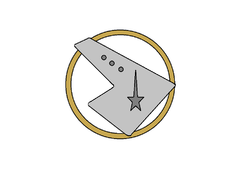Strathan Space Programme
This article needs more links to other articles to help integrate it into the encyclopedia. (July 2023) |
| The Strathan Space Programme | |

| |
| SSP Logo | |
| Motto | Somnia Materiam Quaerere |
| Trans. | To Seek the Stuff of Dreams |
| Current Projects | Project Horizon |
| Headquarters | Communist People's Republic of Strathy |
| Leadership | |
| Chief of Operations
|
James H Whittle |
| Deputy Chief of Operations | Position Vacant |
| Establishment | |
| Founded | 20 June 2011 |
The Strathan Space Programme, or simply The SSP, is the organisation run by the Strathan Government charged with exploring outer space. Founded in mid-2011 by the coalition of The Strathan Observatory and The Strathan Institute for Scientific Research and Development, The SSP has become the largest scientific organisation in Strathy. Its mission is to further scientific knowledge and understanding of the universe through space exploration. Using affordable materials and volunteer scientists and engineers, they hope to put micronations into space and show that space is not simply the domain of the rich and the powerful.
Missions
The Strathan Space Programme is a relatively young venture and has been, until now, mostly concerned with ground-based observations and simulations. However it was decided that new, more practical applications of existing knowledge needed to be utilised- the prominent issue being; can we put a probe into space?
Past Missions
Project Atlas
Project Atlas, launched in September 2011, was a joint venture with the Strathan Observatory and an opening project for the SSP. The Project consisted of ground based observations and computer simulations to observe and chart the celestial bodies and their movements with respect to the observatory. Many objects have been observed and catalogued. More prominent objects include planets of the solar system - specifically Mars' retrograde motion - and a number of stellar constellations such as Orion. Project Atlas is still ongoing, however is now mostly in the domain of The Strathan Observatory.
Project Doppler
Project Doppler was a short, three week project to determine the existence of extra-solar planetary bodies orbiting distant stars. The project observed two phenomena, The Dopple Wobble effect and The Transit Dip. The Doppler Wobble used the fact that any two bodies will attract each other gravitationally. Hence any orbiting planet would drag the star towards it by some amount in its orbit. This allowed the team to observe a Doppler shift in the star's light as it was pulled about, hence allowing the team to determine the mass of the planet and its orbital characteristics. The Transit Dip used the simple fact that as a planet crosses between it's parent star and the observer, a dip in the intensity of light from the star would be observed. This dip, whilst not so accurate of very distant stars, still allowed for observation of the planetary characteristics.
Current Missions
Project Horizon

Project Horizon is the SSP's latest venture. The ultimate goal is to put a functioning satellite into orbit around the Earth to take photographs and send them back to the control centre. This ambition is still a long way from being accomplished and Project Horizon will likely go forward in a number of stages, the first being simply to get a probe past the The Kármán line, ie into space - 62 km above sea level.
The project is in its planning stages just now and designs are still being considered, however, the most popular design so far is that of a rocket that could be launched at altitude from a helium balloon.
Collaboration
As Project Horizon is likely to be very large undertaking, The SSP is currently considering collaborating with other micronational space agencies to accomplish its goal.